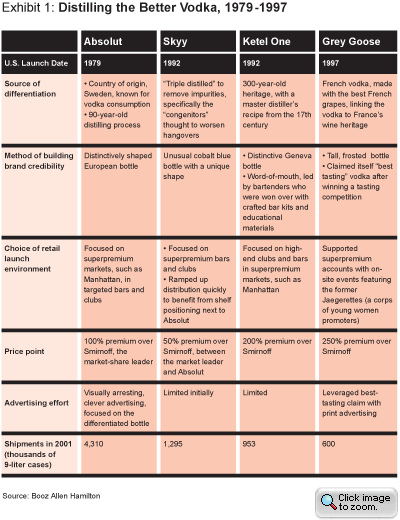The Superpremium Premium
Even in commodity categories, four simple steps can lead marketers to a high-margin brand.
 |
|
Illustration by Lars Leetaru |
That sum is testament to the opportunity presented by premium and superpremium brands, product classes surprisingly available across a wide range of branded goods, and open even in product categories already considered overloaded. In spirits, the share held by superpremium brands rose nearly 11 percent per year between 1985 and 2001, ultimately growing to 30 percent of the market, at average prices that were 90 percent higher than the median for the entire category. Superpremium frozen desserts — 10.5 percent of the total category — garner prices that are more than 150 percent above the market average.
Although the range differs depending on the category, premium brands typically are those that cost consumers 75 to 100 percent more than the category average; superpremium brands are 150 to 200 percent above the average. Superpremiums, especially, represent a nontrivial source of value and growth for marketers, especially as mass brands increasingly are challenged from the bottom by the rapid spread of lower-priced — or, in the parlance, “value” — brands. Moreover, because the value brand share is growing in most categories, manufacturers’ profit margins are declining. One of the few ways to drive real profit growth in a market with these characteristics is to persuade consumers to switch to premium and superpremium — hereafter, “premium-plus” — products.
Yet the alluring road to the premium premium is littered with wrecks. Too many companies, particularly the largest and most established, have relied on marketing alone to create a demand for their premium-plus products, but neglected the quality of the products themselves. Too many have followed initial success with a dialing up of marketing volume, killing the brand’s exclusivity and potential.
These companies are missing an inescapable fact of brand development and management: The creation and maintenance of premium-plus brands requires a structured and integrated approach that is utterly different from the process companies typically employ to sustain mass brands.
Making a Difference
The reflex among consumer marketers is to rely on an ephemeral, hard-to-define approach they call branding to create differentiation among functionally equivalent products. Although this may work with mass brands in established commodity markets, where advertising serves mostly to remind consumers about products they already know, using communications alone to motivate consumers to select a high-priced but functionally indistinct new brand is unlikely to succeed.
Establishing even basic consumer mindshare is far more difficult today than in the decades of three-network hegemony in television. For new brands with limited distribution, the cost of an “advertising über alles” strategy is exorbitant. Therefore, at the beginning of their lives, premium-plus brands must rely on consumers to be the agents of their message. And for consumers to be effective agents, the new brands must have something tangible and distinctive to justify their selection.
This is the case even with commodities. Consider the history of premium gasoline. Developed early in the 20th century, premium gas was manufactured to fuel high-compression engines, which increased the power and fuel economy of the era’s autos but required higher-octane content to avoid performance-degrading knocking. The oil industry standardized a formulation for premium fuel using tetra-ethyl lead, which provided the octane required. One of the prominent category participants was Amoco, which, in 1925, as the American Oil Company, acquired the rights to a high-octane product it labeled Amoco-Gas, produced through a method that did not rely on lead. For the next four decades, Amoco marketed its “super premium” in the old American Oil territory.
In 1970, the Clean Air Act required the industry to stop using tetra-ethyl lead to increase octane, and to switch to unleaded fuels that did not upset the performance of the catalytic converter, the prime tool for reducing vehicle emissions. At the time, leaded products accounted for 98 percent of all gasoline sold in the U.S. Amoco, with its early lead in what had been a niche segment, championed the move toward unleaded gasoline.
Still, this discontinuity in the U.S. fuel market threatened Amoco’s primacy by promising to commoditize unleaded gasoline. But Amoco had another advantage: By virtue of an extra refining step, its unleaded fuel was clear, and lacked the brownish tinge of other premium fuels. Amoco launched a marketing campaign that highlighted this key difference, renaming its premium product “Crystal Clear Ultimate.” In some markets, the company altered its pump mechanism so consumers could see the transparent fuel.
Because cars are a “high involvement” product for so many owners, that visible functional differentiation resonated emotionally with a sizable consumer segment, and gave Amoco two more decades of leadership in the premium fuel category — leadership that held even as improvements in automobile engines and the institutionalization of unleaded gasoline made premium fuels less distinct from regular gasoline, and ever less necessary for cars. Our own April 2004 survey of 2,400 fuel buyers showed that the overwhelming majority of premium fuel buyers still believe their vehicles require premium fuel, and see the purchase as “doing the right thing” for their cars.
Although overall consumer demand for premium fuel products is falling in the gasoline industry, Amoco has maintained its category share in regional markets where Crystal Clear is available. Additionally, BP, the owner of the Amoco brand, is still able to capture a price premium because of the brand’s legacy strength.
The conclusion is inescapable: Even when categories become commoditized, consumer loyalty to a once-distinct product can linger and continue to create value for the brand’s owners.
Translation Barrier
The Amoco story shows that premium-plus marketers must find ways to convert their briefly held, differentiating attribute into a sustainable psychological commitment from consumers. The way to do this is to break down the “translation barrier” between functional differentiation and emotional loyalty, building strong relationships with key consumers.
In our experience across product categories, crossing this translation barrier requires marketers to engage in four activities:
-
Distinction. Embed the differentiated product with demonstrative cues, such as packaging, taste, or significantly distinct “rituals of use,” that reinforce the product’s uniqueness to the consumer and, potentially, to those who interact with him or her.
-
Communication. Build brand credibility and support word-of-mouth promotion by seeding the market with “brand zealots” who can influence the consumer at the point of purchase and attract other likely zealots to the brand.
-
Tangibility. Focus the launch in retail environments that support the brand’s positioning and form part of the differentiated experience, so the memory of the consumption moment reinforces the brand’s image and aligns it to the consumer’s self-image.
-
Price. Select a price point that supports the credibility of the differentiation.
The four-point premium-plus translation strategy is replicable even within a category. For evidence, simply explore that laboratory of superpremium branding, the vodka market.
The top four superpremium vodka brands — Absolut, Skyy, Ketel One, and Grey Goose — followed some version of the four-point plan to turn short-term functional differentiation into longer-term psychological commitment. Each had a significant point of difference in the then-current market; each employed packaging to reify its differentiation; each established a price point well above the mass-market price; and each had a retail strategy that physically touched consumers and/or retailers. (See Exhibit 1.)
Absolut focused on its unusual country of origin, Sweden, and used its innovative ad campaign, built around simple wordplay and clever renderings of its cylindrical bottle, to generate years of attention and buzz. So successful was the campaign — it built emotional loyalty even among nondrinkers — that a compilation of the advertisements was turned into a best-selling book in 1996. Skyy’s purported distinction, by contrast, was unadvertised: A word-of-mouth claim that it reduced the effects of hangovers helped it develop an emotionally loyal user base. Ketel One won converts by providing third parties — bartenders — with carefully crafted bar kits that even included a video describing the brand’s history. Grey Goose used sexy and sophisticated on-premise events, led by the former Jaegerettes, whose provocative dress and joie de vivre had previously (and improbably) helped expand the distribution of the sweet liqueur Jägermeister.
These successful efforts to use brand zealots to motivate consumers to switch to premium-plus brands are well grounded in academic research. The importance of “personal influence” on consumer behavior has been recognized at least since the 1950s, when Paul Lazarsfeld and Elihu Katz published a famous study of the same title showing that communication operates according to a “two-step flow,” in which word-of-mouth strengthens media messages.
Tactically, leveraging interpersonal communications is even more critical in premium-class efforts than in mainstream marketing campaigns. Consumers willing to purchase premium-plus brands in a particular category already experience disproportionate utility from the category, which indicates the category is bound up in their identity. When consumers’ judgments have strong, identity-based components, social influence is much more effective than analytical efforts at encouraging individuals to switch brands, according to research by Lisa Bolton and Americus Reed II of the University of Pennsylvania’s Wharton School of Business. (See "Brand Zealots: Realizing the Full Value of Emotional Brand Loyalty," by Horacio D. Rozanski, Allen G. Baum, and Bradley T. Wolfsen, s+b, Fourth Quarter 1999.)
The first three elements of a premium-brand strategy are, finally, reinforced by pricing. Each of the four successful superpremium vodkas chose a price point for entry that was uncluttered and that reinforced its status. Absolut’s launch price was $16 per liter, roughly twice the price of Smirnoff in 1979. Eighteen years later, Grey Goose priced itself at more than $30, 50 to 75 percent more than the current price of Absolut.
Get Scarce
High pricing helps maintain the appearance of scarcity — a challenge that is among the most difficult for mass marketers attempting to launch premium brands.
The desire to “go wide” is seemingly embedded in mass marketers’ DNA. Because of the performance expectations they attach to their investments, mass marketers frequently kill premium-plus brands with too much capital. In many instances, incumbent mass companies have experienced initial success in the premium space only to have the product collapse during its transition onto mass platforms, where large marketers believe the “real growth” will occur. This, ironically, is a primary reason entrepreneurs typically are more successful than established brand marketers at launching premium-plus products: Their capital disadvantages prevent them from overinvesting.
Consider how Boston Beer Company used a low-investment, four-element strategy to launch the Samuel Adams brand, now arguably the most successful of the U.S. microbrews.
The product was made according to a special old recipe, underscoring the new company’s putative heritage and quality and establishing its functional differentiation. At a time when the best-selling premium beer, Heineken, was imported by ship, Jim Koch, Boston Beer’s founder, emphasized in trade and consumer communications the local provenance and resulting freshness of Sam Adams. Though Boston Beer used distributors to transport its product to high-end retail establishments, it also maintained a sales force to sell in at retail, coordinate retail programs, and build tangible enthusiasm among customers. By contracting the manufacturing and essentially making production cost variable, the company eliminated the need to invest in large chunks of capacity before retail sales materialized, and avoided the incentive to push the beer into the market too rapidly. Finally, like most of the microbrews, Sam Adams was priced at a premium over Heineken. All four components worked together to pull the beer across the translation barrier into the market.
Though the opportunity for premium brands exists in almost every product category, a company must answer several questions to determine if the pursuit of the opportunity is consistent with its capabilities. Are the revenue and profit potential significant, relative to current financial performance? Will the organization kill the brand with an overinvested push strategy? Is it better to build a premium-plus brand, as Jim Koch did with Sam Adams, or acquire it, as Bacardi did with Grey Goose? Finally, and most importantly, does the company have the capabilities — the technical skill to create a differentiated product, channel access, and consumer savvy — required to support a successful superpremium launch?
With superpremium vodkas successfully launching two or three times a decade, and with premium-plus gasoline brands retaining their pull and profitability more than 75 years after their introduction, it’s clear that consumers’ appetite for the high end is insatiable — and marketers’ chance for profit equivalently grand. In today’s low-growth, low-margin environment, that means consumer products companies must break every rule of mass marketing — in a very structured way.![]()
Reprint No. 04401
Author profiles:
Leslie H. Moeller (moeller_leslie@bah.com) is a vice president with Booz Allen Hamilton in Cleveland. He specializes in the development of growth strategies, especially for packaged-goods and retailing companies.
Nick Hodson (hodson_nicholas@bah.com) is a vice president with Booz Allen Hamilton in San Francisco. He concentrates on strategy and transformation in consumer-facing industries.
Brad Wolfsen (wolfsen_brad@bah.com) is a principal with Booz Allen Hamilton in San Francisco. He focuses on customer-facing strategy and marketing issues across industries.
Research assistance for this article was contributed by Michelle van de Braak, an associate in Booz Allen’s San Francisco office.




